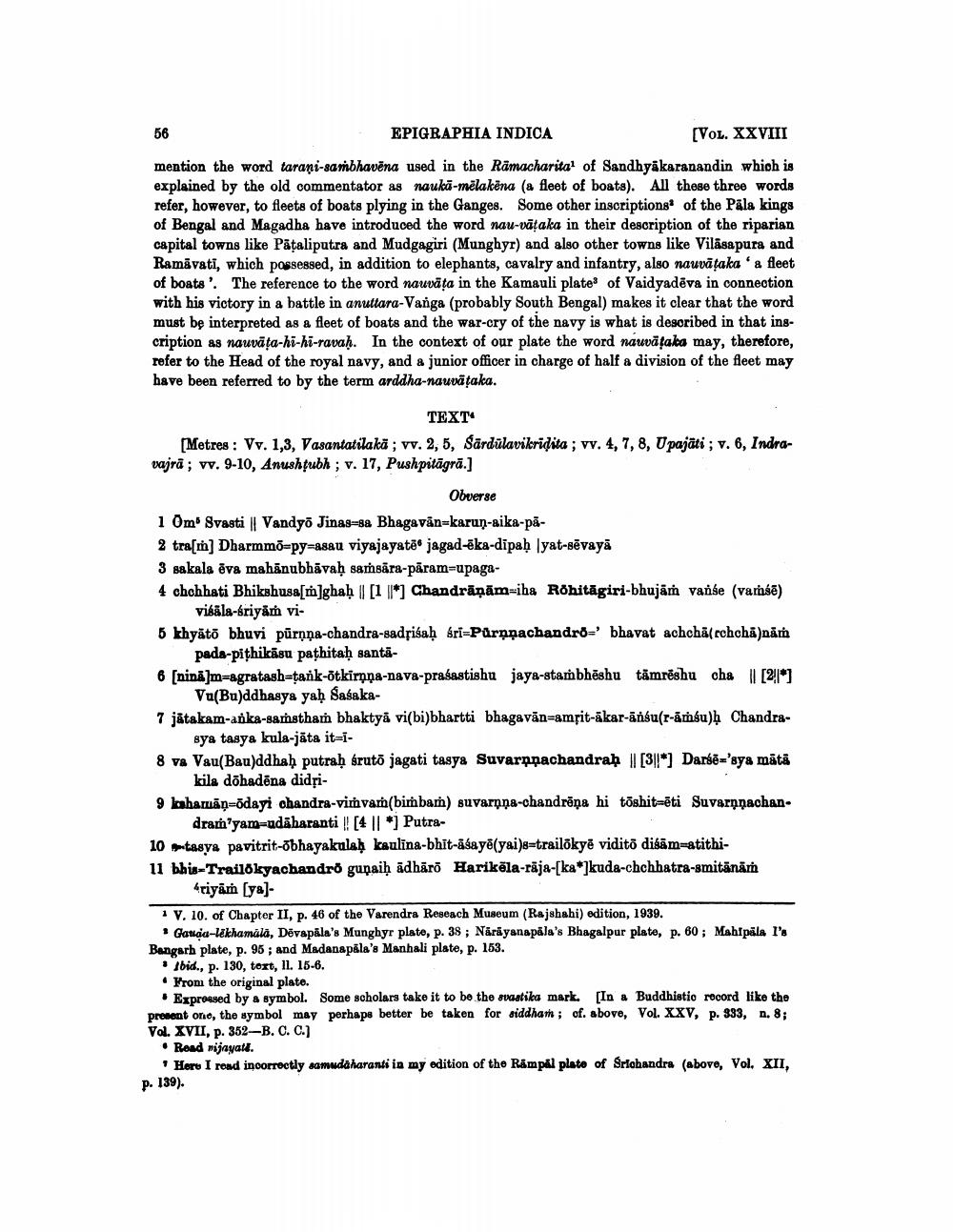________________
EPIGRAPHIA INDICA
(VOL. XXVIII mention the word tarani-sambhavëna used in the Ramacharita' of Sandhyakaranandin which is explained by the old commentator as nauka-melakëna (a fleet of boats). All these three words refer, however, to fleets of boats plying in the Ganges. Some other inscriptions of the Pala kings of Bengal and Magadha have introduced the word nau-vātaka in their description of the riparian capital towns like Pātaliputra and Mudgagiri (Munghyr) and also other towns like Vilāsapura and Ramăvati, which possessed, in addition to elephants, cavalry and infantry, also nauvātaka ' a fleet of boats'. The reference to the word nauvāta in the Kamauli plates of Vaidyadēva in connection with his victory in a battle in anuttara-Vanga (probably South Bengal) makes it clear that the word must be interpreted as a fleet of boats and the war-cry of the navy is what is described in that ingcription as nauvāța-hi-hi-ravah. In the context of our plate the word nauvafaka may, therefore, refer to the Head of the royal navy, and a junior officer in charge of half a division of the fleet may have been referred to by the term arddha-nauvataka.
TEXT [Metres: Vy. 1,3, Vasantatilakā; vv. 2, 5, Sārdūlavikridita ; vy. 4, 7, 8, Upajāti; v. 6, Indravajrā; vv. 9-10, Anushtubh ; v. 17, Pushpitāgrā.]
Obverse 1 Om Svasti || Vandyo Jinas=sa Bhagavān=karun-aika-pa2 tra[m] Dharmmā=py=asau viyajayatēs jagadēka-dipah (yat-sēvayā 3 sakala ēva mahānubhāvaḥ samsāra-param=upaga4 chchhati Bhikshusa[m]ghaḥ || [1 I*] Chandrānām=iha Rohitāgiri-bhujām vanse (varsē)
vikāla-briyam vi5 khyāto bhuvi pūrņņa-chandra-sadpiśaḥ śrī=Purppachandro' bhavat achchä(rchcha)năm
pada-pithikāsu pațhitaḥ santā6 [ninā]m=agratash=tank-otkirņņa-nava-prasastishu jaya-starbhēshu tāmrëshu cha || [211*]
Vu(Bu)ddhasya yah Saśaka7 jātakam-anka-samstham bhaktyä vi(bi)bhartti bhagavān=ampit-akar-ansu(r-āmáu)h Chandra
sya tasya kula-jäta iti8 va Vau(Bau)ddhah putraḥ sruto jagati tasya Suvarnpachandrah || [311*] Darsē='sya mātā
kila dōhadēna didsi9 bahamāņ=õdayi chandra-vimvam bimbam) suvarnna-chandrēna hi tõshit-ēti Suvarnnachan
dram'yam=adāharanti! [4 II *] Putra10 rtasya pavitrit-obhayakulah kaulina-bhit-āsa ye(yai)8=trailokyē vidito disām atithi11 bhis-Trailökyachandrő gunaiḥ ādhāro Harikēla-rāja-[ka*]kuda-chchhatra-smitānām
kriyām (ya)1 V. 10. of Chapter II, p. 46 of the Varendra Reseach Museum (Rajshahi) edition, 1939.
Gatica-lekhamālā, Dēvapāla's Munghyr plate, p. 38; Nārāyanapala's Bhagalpar plate, p. 60; Mahipala l'a Bangarh plate, p. 95; and Madanapala's Manhali plate, p. 153.
Ibid., p. 130, toxt, 11. 15-6. • From the original plate.
. Expressed by a symbol. Some scholars take it to be the swatika mark. [In a Buddhistio rocord like the present one, the symbol may perhaps better be taken for siddhan ; of. above, Vol. XXV, p. 983, n. 8; Vol. XVII, p. 352-B. C. C.) • Road nijayatt.
Here I road incorrectly samudaharanti in my edition of the Rampal plate of Srichandra (above, Vol. XII, p. 139).




